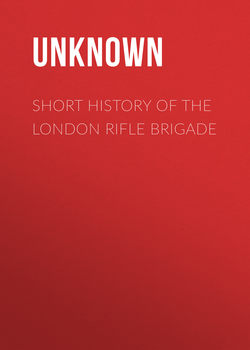Читать книгу Short History of the London Rifle Brigade - Unknown - Страница 3
PART II
ОглавлениеMobilisation
The Battalion mobilised on the outbreak of war. It had actually gone into camp at Eastbourne, but was brought back to London within a few hours of its arrival.
A second and third Battalion were soon formed. (See pp. 30, 31.)
First Battalion
Making stays of varying duration en route at Wimbledon, Hersham, and Bisley (for three weeks), the 1st Battalion finally reached Crowborough, where it remained under canvas until ordered abroad.
It embarked on November 4th, 1914. The following were the officers:—
Lieut.-Col. W. D. Earl Cairns (Commanding).
Lieut.-Col. (Hon. Col.) C. G. R. Matthey, V.D. (Second-in-Command).
Major.—N. C. King, T.D.
Captains.—A. S. Bates, M. H. Soames, R. H. Husey, C. H. F. Thompson, H. F. MacGeagh, J. R. Somers-Smith, A. L. Lintott, and Hon. Major C. D. Burnell.
Lieutenants.—R. E. Otter, J. G. Robinson, G. H. Morrison, E. L. Large, P. A. Slessor, H. B. Price, A. G. Kirby, G. H. Cholmeley.
Second-Lieutenants.—K. Forbes, G. H. G. M. Cartwright, W. L. Willett, H. L. Johnston, C. W. Trevelyan, H. G. Vincent, G. E. S. Fursdon, G. C. Kitchin.
Adjutant.—Captain A. C. Oppenheim, K.R.R.C.
Quartermaster.—Lieutenant J. R. S. Petersen.
Medical Officer.—Major A. D. Ducat, T.D.
The following short account is written in constant remembrance of the censorship regulations, and with a view to giving a faint outline of its doings to those who were not out with the 1st Battalion in France. It will be an aid to memory to those who were with it, and are fortunate in being able to look back on a time when the 1st Battalion undoubtedly reached its zenith.
Never can any Battalion of the Regiment be better than was the 1st London Rifle Brigade in 1914-15. That all will endeavour to be as good is quite certain.
1914. Nov. 5th
The Battalion arrived in France. Disembarkation was a tedious business, and the progress through the town to the rest camp at the top of the hill was one of the worst forms of route march the Battalion had ever experienced. Frequent checks, but no halts, taught the true weight of packs and kit; and a perfunctory inspection on arrival at the camp completed the exhaustion.
For the next three weeks the history of the Battalion was one common to those Territorial units which were sent out as lone Battalions about that time. It comprised a glorious uncertainty, which troops coming out earlier and later in complete divisions cannot have experienced. For instance, on landing it was learnt, quite by accident, but on excellent authority, that officers no longer wore Sam Browne belts or carried swords. A frantic rush at the last moment procured web equipment just before the parade to entrain. Swords and belts were left at the base.
Nov. 6th
There was much to learn about entrainment in France. An advance party had been sent forward some two hours earlier, and the rest of the Battalion and the transport were at the station by 4 p.m. The train was not due to leave until 9 p.m. French trains and the French railway system became familiar later on in all their ramifications, but at first "Hommes 40 Chevaux (en long) 8" aroused suspicions that were only too well justified in the next 21½ hours before the train reached its destination. The experience was not a unique one.
Nov. 7th
On arrival at General Headquarters it was found that the Battalion was not even expected, and no arrangements had been made for the night. After a wait of three hours in the train, the Battalion moved off into some old artillery barracks, which were destined to become more familiar later on. The quarters were, at that time, about as dismal and dirty as can be imagined.
Nov. 8th
The Battalion marched out some three and a half miles to a large unfurnished and unfinished convent, which accommodated the entire strength.
There was no water laid on, no light, no method of heating or of drying clothes, no furniture, and no possibility of supplementing rations. The only bright spot was the first introduction to the rum ration.
Training, which consisted chiefly of trench digging and artillery formation, was carried out daily regardless of the weather.
The Battalion was apparently considered to be up to the required standard of efficiency and hardness, or else the authorities had not the heart to keep it there longer, for on the 15th orders were received to march the next day.
Nov. 16th
The distance was 17½ miles, and the roads pavée almost the whole way. There was also some rain. In spite, however, of the absence of other Battalions to keep them on their mettle, not a single man fell out of the column.
Nov. 17th
Except for bruised feet, the march next day, about 11 miles, was not very trying. Two nights were spent at this town, where the Artists and Honourable Artillery Company were also in billets.
While on the march it had been possible, for the first time, to see aeroplanes being shelled, and, while in these billets, the Battalion learnt what it meant to see the remnants of a Brigade come out of action.
Nov. 19th
The Battalion moved one stage nearer to the firing line in a snow-storm.
Nov. 20th
Brigadier-General Hunter Weston paid the Battalion a visit, and addressed the Officers. He gave a short account of the 11th Infantry Brigade, which he commanded, and to which the London Rifle Brigade was attached, and outlined the scheme of training. Half-companies were to be attached to Regular Battalions for a spell in the trenches, the men being scattered amongst the Regulars. As soon as their worth had been proved, half-companies were to be put in the line intact, and later whole companies.
